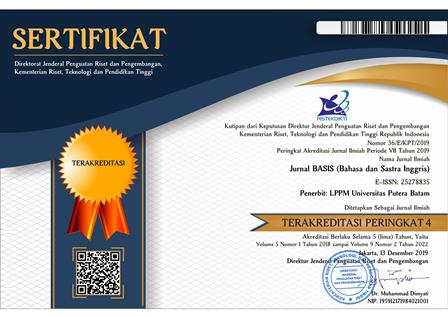KONSTRUKSI IDENTITAS BERDIMENSI KULTURAL PADA ORANG TERKAYA DI INDONESIA VERSI FORBES
Condra Antoni. Politeknik Negeri Batam condra@polibatam.ac.id
Keywords:
konstruksi identitas, narasi bisnis, dimensi kultural, analisis wacanaAbstract
People use language to construct their identity or identities and narrative is one of the forms of the language use. The narrative functions as a site for enacting what they are, who they are, and how they view the others (Gee, 2011). This paper discusses the identity construction in the narrative of the 2015 richest Indonesian people ranked by Forbes magazine. A discourse analytic approach is employed in this study. The analysis shows that the identity constructions are relevant to the cultural dimensions proposed by Hofstede (1987, 2016) in which the collectivistic culture emerged predominantly in the narrative. Since the data were taken from English narratives in business, the implication for the use of English as a business’ lingua franca is also discussed.
References
Credit-Suisse. (2016). The Conference. Retrieved September 19, 2016, from https://www.credit-suisse.com/microsites/conferences/aic/en/the-conference.html
Silitonga, f. (2018). THE VOCABULARY UNDERSTANDING OF READING TEXT IN HOSANNAH BATAM SCHOOL. BASIS (BAHASA DAN SASTRA INGGRIS), 2(2), 111-116. Retrieved from http://ejournal.upbatam.ac.id/index.php/basis/article/view/310
Digital Narrative of Asia. (2015). Digital Narratives of Asia | Institute for Societal Leadership. Retrieved September 19, 2016, from http://isl.smu.edu.sg/DNA
Du-Babcock, B., & Tanaka, H. (2016). A Linguistic Approach to Management Research: Leadership in Intercultural English Meetings in Asia. Bulletin of the Transilvania University of Braşov, Series VII: Social Sciences and Law, 9(1), 119–130.
Dubina, I. N., & Ramos, S. J. (2016). Cultural Underpinnings in Entrepreneurship. In Creativity, Innovation, and Entrepreneurship Across Cultures, Theory and Practices (pp. 147–153). Springer New York. http://doi.org/10.1007/978-1-4939-3261-0_12
Forbes. (2015). Indonesia’s 50 Richest List. Retrieved September 14, 2016, from http://www.forbes.com/indonesia-billionaires/list/
Gee, J. P. (2011). An Introduction to Discourse Analysis: Theory and Method (3rd ed.). New York: Routledge.
Gee, J. P. (2015). Discourse, Small d, Big D. In The International Encyclopedia of Language and Social Interaction (pp. 1–5). Hoboken, NJ, USA: John Wiley & Sons, Inc. http://doi.org/10.1002/9781118611463.wbielsi016
Gerritsen, M., & Nickerson, C. (2009). BELF: Business English as a lingua franca. In F. Bargiela-Chiappini (Ed.), The Handbook of Business Discourse (pp. 180–192). Edinburgh: Edinburgh University Press.
Hofstede, G. (1987). The Applicability of McGregor’s Theories in South East Asia. Journal of Management Development, 6(3), 9–18. http://doi.org/10.1108/eb051642
Hofstede, G. (2016). The hofstede centre. Retrieved from https://geert-hofstede.com/
42
KBBI Online. (2016). Arti kata narasi - Kamus Besar Bahasa Indonesia (KBBI) Online. Retrieved September 15, 2016, from http://kbbi.web.id/narasi
Labov, W., & Waletzky, J. (1997). Narrative Analysis: Oral Versions of Personal Experience. Journal of Narrative and Life History, 7(1), 3–38. http://doi.org/10.1075/JNLH.7.02NAR
Ladegaard, H. J. (2012). The discourse of powerlessness and repression: Identity construction in domestic helper narratives 1. Journal of Sociolinguistics, 16(4), 450–482. http://doi.org/10.1111/j.1467-9841.2012.00541.x
Downloads
Published
Issue
Section
License













 JURNAL BASIS (BAHASA DAN SASTRA INGGRIS)
JURNAL BASIS (BAHASA DAN SASTRA INGGRIS)
